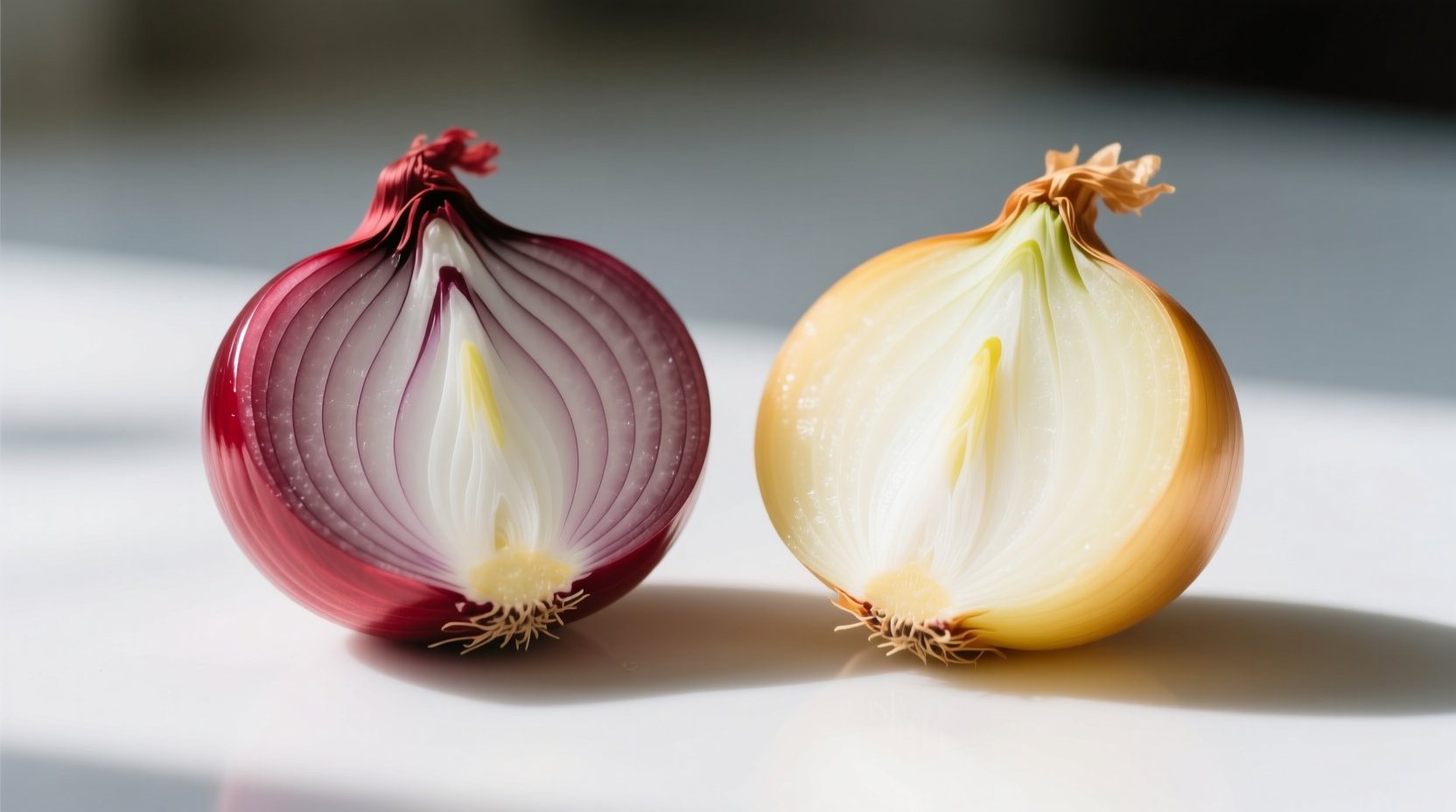Red onions feature vibrant purple skin and a sharper, more pungent flavor ideal for raw applications like salads and salsas, while yellow onions have a stronger sulfur content that mellows beautifully when cooked, making them the preferred choice for caramelizing, roasting, and most cooked dishes. Understanding these red onion vs yellow onion differences ensures perfect flavor balance in every recipe.
Choosing between red and yellow onions can make or break your dish. As a professional chef who's worked with both varieties across countless recipes, I've seen how this simple decision impacts flavor profiles, color presentation, and even cooking times. Let's cut through the confusion with practical, kitchen-tested guidance you can trust.
Core Differences at a Glance
| Characteristic | Red Onion | Yellow Onion |
|---|---|---|
| Outer Skin Color | Deep purple-red | Brownish-gold |
| Inner Flesh Color | Reddish-purple | White with yellow tinge |
| Raw Flavor Profile | Sharper, spicier, more pungent | Stronger sulfur notes, more astringent |
| Cooked Flavor Profile | Mellows but retains some bite | Develops rich sweetness, caramelizes beautifully |
| Sugar Content | 12-14% | 15-18% (higher for better caramelization) |
| Storage Life | 2-3 weeks at room temperature | 2-3 months when properly stored |
Flavor Chemistry: Why They Taste Different
The distinct flavors come down to sulfur compounds and sugar content. Yellow onions contain higher levels of sulfur compounds that transform into sweet flavor molecules when heated, according to research from the USDA Agricultural Research Service. This chemical reaction explains why yellow onions caramelize more effectively than their red counterparts.
Red onions contain anthocyanins—the same antioxidants found in blueberries—which give them their distinctive color and slightly different flavor profile. These compounds provide additional health benefits but affect how the onion behaves in cooking. When cooked for extended periods, red onions can turn an unappetizing blue-gray color, making them less suitable for long-cooking applications.

When to Use Red Onions: Raw Applications
Red onions shine in raw preparations where their vibrant color and crisp texture enhance dishes:
- Salads and salsas: Their color adds visual appeal while their sharper flavor cuts through rich ingredients
- Pickling: The anthocyanins create beautiful pink pickled onions that maintain their color
- Garnishes: Thinly sliced red onions provide both flavor and visual contrast on tacos, burgers, and sandwiches
- Ceviche and raw fish dishes: Their acidity complements citrus-marinated seafood
For raw applications where red onion's bite might be too strong, try soaking sliced onions in ice water for 10-15 minutes. This simple technique reduces pungency while maintaining crisp texture—a professional chef's trick I've used in restaurant kitchens for years.
When to Use Yellow Onions: Cooking Applications
Yellow onions are the workhorses of the culinary world, particularly for cooked dishes:
- Caramelizing: Their higher sugar content creates deeper, richer caramelization (takes 30-45 minutes)
- Soups and stews: They dissolve completely, creating a flavor foundation without distracting color
- Roasting and grilling: Their flavor mellows beautifully while developing complex sweetness
- Sauces and gravies: They blend seamlessly without altering color
- French onion soup: The classic choice for authentic flavor and texture
Professional kitchens use yellow onions for approximately 80% of cooked applications according to Culinary Institute of America teaching materials. Their versatility makes them the most commonly used onion variety in professional cooking.
Substitution Guidance: When Swaps Work (and When They Don't)
Understanding red onion vs yellow onion substitution limitations prevents recipe disasters:
Acceptable substitutions:
- Yellow for red in cooked applications (with minor color difference)
- Red for yellow in quick-cooking dishes like stir-fries (under 10 minutes)
Problematic substitutions:
- Using red onions in long-simmered tomato sauces (color turns unappetizing)
- Substituting yellow onions in fresh pico de gallo (lacks visual appeal and proper flavor balance)
- Using yellow onions raw in delicate salads (overpowering flavor)
When substituting, adjust quantities—use 25% less yellow onion when replacing red in raw applications due to stronger flavor. For cooked dishes, you may need to extend cooking time by 5-10 minutes when using red onions instead of yellow to achieve proper caramelization.
Selection and Storage Tips
Choose firm onions with dry, papery skins free of sprouts or soft spots. For maximum shelf life:
- Store both varieties in a cool, dark, well-ventilated place (not the refrigerator)
- Keep away from potatoes which emit gases that accelerate onion spoilage
- Yellow onions last significantly longer—typically 2-3 months versus 2-3 weeks for red onions
- Never store cut onions in plastic bags; use perforated containers to maintain airflow
When properly stored, yellow onions develop more complex sugars over time, enhancing their caramelization potential. Red onions, however, gradually lose their vibrant color and sharp flavor during extended storage.
Practical Application Scenarios
Understanding context boundaries helps you make the right choice for specific dishes:
- Onion rings: Yellow onions provide better texture and flavor balance
- Guacamole: Red onions add visual contrast without overwhelming avocado's delicate flavor
- Beef bourguignon: Yellow onions essential for proper flavor development
- Ceviche: Red onions preferred for color and balanced acidity
- Onion soup: Yellow onions create the authentic sweet-savory base
- Grilled vegetable platters: Red onions maintain better appearance when grilled
Professional chefs often use both varieties in the same dish—yellow onions as the flavor foundation and red onions as a fresh garnish. This technique creates layered onion flavor that elevates simple recipes.











 浙公网安备
33010002000092号
浙公网安备
33010002000092号 浙B2-20120091-4
浙B2-20120091-4